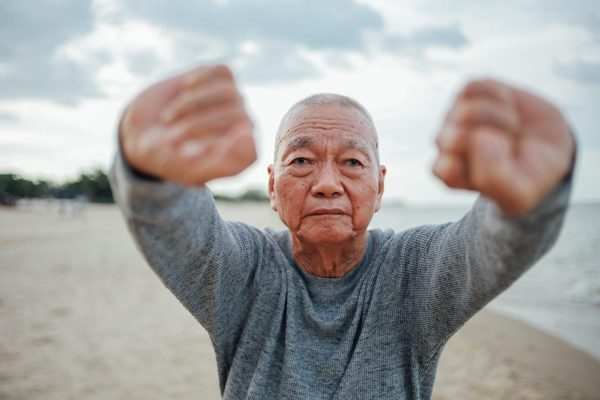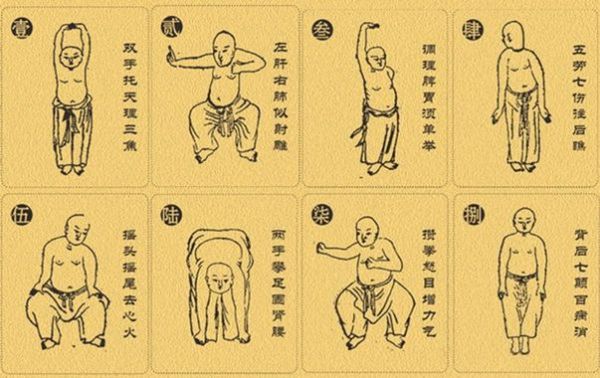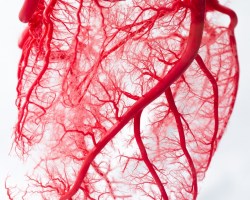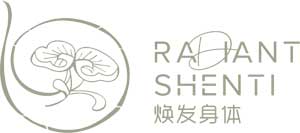Qigong meditation breathing exercises will help you awaken your body’s innate healing. As a result, you will prevent or reverse disease, look younger, and feel more energized.
Reading time: 7 minutes
Watch the qigong meditation breathing exercises video
A Tale of Two Mindsets
When I think about being healthy, the differences between my experiences in the United States and Asia come into stark contrast. People have radically different perspectives of health and what that means for their lifestyles and happiness.
These following two tales will help you determine if you have the proper mindset to allow qigong meditation breathing exercises to awaken your innate healing.
Tale one: The United States
In the U.S., my friends and family, as well as other people I come in contact with, are worried about making sure they have a main floor master bedroom because they won’t be able to walk up the stairs as they get older. They take it as a given that their knees and hips will give out and probably need to be replaced.
Additionally, in regard to a healthy mind, people dread the potential of Alzheimer’s and dementia. The threat of the mind deteriorating looms large, with a sense of powerlessness to stop the onslaught.

Furthermore, talk almost always turns to medications they have to take, as an inevitable part of getting older. Movies, television, and social media reflect this mindset that “of course” you will have to take a wide assortment of pills as you get older. Only rarely will I see mention of the body’s innate healing ability over taking medications.
Unless I am around people who already know the power and wisdom of qigong meditation breathing exercises, I never hear people talking about this healing tool.
Tale two: Asia and qigong meditation breathing exercises
In contrast, in Asia, people maximize innate healing. They work consistently to develop strong, supple, and flexible minds and bodies well into their 90s and beyond. Qigong meditation breathing exercises and other similar practices are a natural part of daily life.
Firstly, when I lived in China and was fortunate enough to travel to nearby countries, such as Japan and South Korea, I saw old people outside all of the time.
Whether they walked to the market to purchase fresh vegetables for the day, strolled with friends after dinner, or met at the park to stretch, dance, or do qigong meditation breathing exercises, old people were out and about.

And, whether in China, South Korea, or Hong Kong, I walked side-by-side with people easily in their 80s and 90s up demanding roads, paths, mountains, and steep hills.
Along the way, people would stop and breathe deeply, consciously, and purposely, doing qigong meditation breathing exercises.
Secondly, knowledge about what types of exercise to do infused the culture, especially the older generations.
They knew what to do and why!
To illustrate, people had access to well-researched exercise routines that hundreds would do together in parks all over China.
Additionally, skilled teachers of qigong, taijiquan, dance, lian gong shi ba fa, etc. led these exercises morning, afternoon, and night. Qigong meditation breathing exercises were practiced by most people, even when they chose other forms of movement.
Living according to the second mindset
The good news is you change your mindset and actions.
It’s never too late!
Research from China since the 1970s, and more globally since the 1980s, demonstrates that making just one lifestyle change, doing qigong meditation breathing exercises and other qigong movements consistently, can help you do the following:
What are qigong meditation breathing exercises?
An ancient healing practice
Qigong in ancient China was also called tuna (adjustment of breathing), daoyin (moving the body and breathing), zuochan (sitting in meditation), or neigong (internal exercise). These translations help you see the importance of breathing and using your mind when doing qigong meditation breathing exercises.
Qigong originated from primitive people’s efforts to nurture their health. In fact, in 1957, when archaeologists excavated graves from over 5,000 years ago, they found a colored ceramic basin painted with a figure doing various qigong movements.

Additionally, from the 5th century BCE, scientists found a complete inscription describing qigong meditation breathing exercises. You can read the inscription below.
One lives if he follows this truth or dies if he acts against it.
Ancient Chinese text
In a cycle of breathing, a deep breath allows more air to be inhaled into the lungs. Expand the breath until it can go no deeper. When the air is exhaled, it is like the budding of the grass and trees, which continue to grow. Its exit route is opposite of that of its intake, and it exits completely. When breathing, inhalation is like a heavenly secret, moving upward; exhalation is more of an earthly secret, moving down. One lives if he follows this truth or dies if he acts against it.
You might have experienced what these ancients tapped into millennia ago.
For example, when you feel tired, you yawn, stretch, or sit with your eyes closed. After a few moments, you’re relaxed and more energized.

And, just like you, ancient people in China did these actions unconsciously. Over time, they started to explore doing them consciously. As a result, they developed more complex skills that created the same feelings of calm.
Also, they noticed that people who did the movements were healthier and did not suffer from illness as often.
Modern innate healing
A nice description of qigong meditation breathing exercises for modern times is the skill of physical and mental training which weaves together the functions of the body, breathing, and the mind. When you integrate these three elements, you adjust the yin and yang balance in your body to prevent and reverse physical and mental disease.
There is an old saying in Chinese medicine, “A good doctor prevents disease rather than merely curing it.”
This concept is one of the first benefits that comes from doing qigong meditation breathing exercises. You will have the tools you need to heal your body, mind, and spirit.
How do qigong meditation breathing exercises work?
According to the principles of Traditional Chinese Medicine, the root cause of all disease can be traced to an imbalance within the body’s vital energies. Therefore, the best way to prevent or cure disease is to restore this balance.
The concept of wholeness is at the heart of Chinese qigong meditation breathing exercises. The parts of the human body function in a coordinated way and influence each other.

Working holistically to fight illness and disease
Embedded within wholeness is the idea that the mind and body are one.Therefore, qigong regards the seven emotions (joy, anger, overthinking, worry, sorrow, fear, and shock) as the internal cause of disease.
Additionally, the six excesses (wind, cold, summer heat, humidity, dryness, and fire) are the external causes of all ailments.
Qigong meditation breathing exercises protect the body against both internal and external factors that cause illness and disease.
Furthermore, when the mind and body are balanced, symptoms of poor health (gray hair, painful joints, balance problems, memory loss, etc.) do not arise until well after 60 years of age. Even then, the symptoms are minor until someone reaches their 90s.
What are benefits of qigong meditation breathing exercises and qigong movements?
Improve your state of mind and memory
Qigong is a form of exercise that requires you to use your mind and imagination. For example, when doing the slow, fluid movements, you focus on your breath and how to do the movements. A sense of relaxation penetrates your mind and body as you focus.
At first it might be a challenge for you to concentrate. However, over time, as you continue to practice qigong, your mind will sharpen. You will find it easier to direct your attention to what you are doing.
Strengthen your respiratory and cardiovascular systems
The most powerful physiological change from qigong meditations breathing exercises is the movement of breath through your body, your respiration. Qigong enhances your ability to draw in longer, deeper breaths. The breaths are even and soft and linked to the movements.
Improving your ability to breathe deeply and with greater ease calms the nervous system. This effect in turn releases tension the heart, improves your circulation and blood vessels.
The most immediate effect is a lowered heart rate that supports ideal blood pressure, not too low or too high. Therefore, qigong is an excellent choice of exercise to cure cardiovascular disease.

Are you at risk for cardiovascular disease? Take the Body Type Quiz to see if your body type puts you at risk. Click here.
Improve digestion through qigong meditations breathing exercises
You might be one of the millions of people diagnosed with some sort of digestive disorder. If you have a problem or just want to keep your digestion healthy, qigong is a perfect choice.
Because abdominal breathing is used during qigong, it helps to regularly massage the organs and cavities of your body.
As a result, qigong promotes the involuntary muscle contractions of the stomach and intestines. This improves circulation in your digestive organs, strengthening their functions. Additionally, this internal massage support healthy hormone levels.
Taking the first step towards healing
You now have a preliminary understanding of what qigong is and how qigong meditations breathing exercises heal the body.
Qigong meditation breathing exercises video
Your next step is to learn how to focus on and control your breath.
Watch any baby breathing. You will see the lower abdomen expand and fall with ease.

Pay attention to your breathing.
You will probably notice that you breathe mostly in your chest. Learning how to take deep abdominal breaths will start you on a journey to healthy aging and better health.
This qigong video guides you through the different types of qigong meditation breathing.
As you do the qigong meditations breathing exercises in the video, you will reconnect with what came naturally to you as a baby.
As the saying goes, "The best time to plant a tree was 20 years ago. The next best time is now."
Plant the seeds to activate your body's innate healing with Radiant Shenti toay!
Qigong Meditation Breathing Exercises References
Zhang, Y. (2020). A comprehensive handbook of Traditional Chinese Medicine.
Zhou, Q. (2013). 10-Minute Primer: Qigong.
Shanghai Qigong Research Institute. (2015). Dictionary of Common Qigong Glossary.


